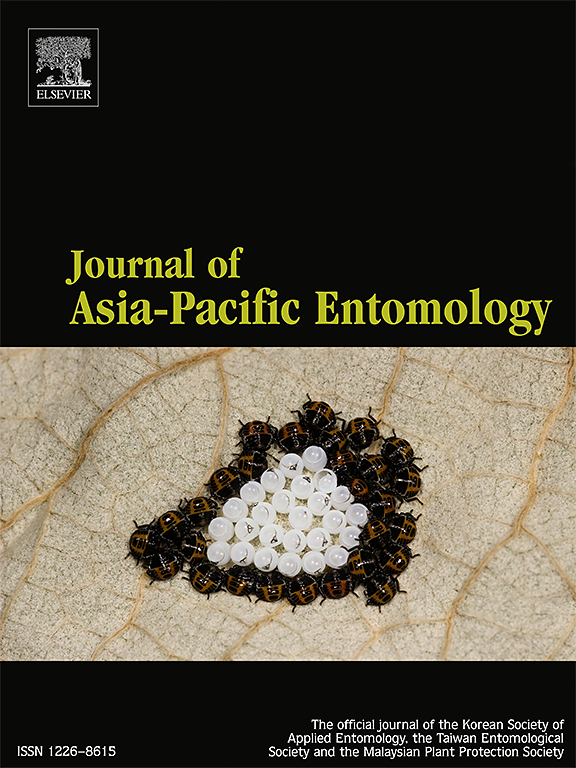Identification and functional characterization of an antennal glutathione S-transferase in Protegira songi (Lepidoptera Noctuidae)
IF 1.1
3区 农林科学
Q3 ENTOMOLOGY
引用次数: 0
Abstract
Glutathione S-transferases (GSTs) in insects are essential biotransformation enzymes that play an important role in the degradation of endogenous and exogenous compounds, including xenobiotics, odorant molecules and many other substrates. In this study, nineteen GSTs were identified in Protegira songi, which is a monophagous pest that specifically infests the valuable medicinal and rubber producing plant Eucommia ulmoides. These PsGSTs are members of the cytosolic GST family and contain the N-terminal glutathione (GSH) binding domain and the C-terminal substrate binding domain. Expression analysis revealed that eighteen PsGSTs are expressed in the antennae of both males and females. Among them, PsGSTd2 is a signal peptide containing GST and is primarily expressed in male and female antennae. Phylogenetic analysis showed that PsGSTd2 shares close relationship with olfactory GSTs in other insects. Protein structure analysis showed that the GSH and substrate binding sites in PsGSTd2 form a reaction center in the monomer. In the catalytic assays, recombinant PsGSTd2 exhibited high degradation activity towards 1-chloro-2, 4-dinitrobenzene (CDNB) and the host plant volatile trans-beta-damascenone, but no degradation activity towards cis-geraniol and 2-furanmethanol was observed. These results suggest that PsGSTd2 is an extracellular GST primarily expressed in the olfactory tissues and may function as an odorant degrading enzyme by specifically inactivating host plant volatiles.

松姬蝶触角谷胱甘肽s -转移酶的鉴定及功能表征
谷胱甘肽s -转移酶(GSTs)是昆虫体内必不可少的生物转化酶,在降解内源性和外源性化合物(包括异种生物、气味分子和许多其他底物)中发挥重要作用。本研究共鉴定出19个gst,该害虫是一种专为药用和橡胶生产植物杜仲(Eucommia ulmoides)而生的单食害虫。这些psgst是细胞质GST家族的成员,含有n端谷胱甘肽(GSH)结合域和c端底物结合域。表达分析显示,18个PsGSTs在雄性和雌性的触角中均有表达。其中,PsGSTd2是一种含有GST的信号肽,主要表达于雄性和雌性触角中。系统发育分析表明,PsGSTd2与其他昆虫的嗅觉GSTs具有密切的亲缘关系。蛋白结构分析表明,GSH与PsGSTd2的底物结合位点在单体中形成一个反应中心。在催化实验中,重组PsGSTd2对1-氯- 2,4 -二硝基苯(CDNB)和宿主植物挥发性反式- β -达马ascenone具有较高的降解活性,但对顺式香叶醇和2-呋喃甲醇没有降解活性。这些结果表明,PsGSTd2是一种主要在嗅觉组织中表达的细胞外GST,可能通过特异性灭活寄主植物挥发物而发挥气味降解酶的作用。
本文章由计算机程序翻译,如有差异,请以英文原文为准。
求助全文
约1分钟内获得全文
求助全文
来源期刊

Journal of Asia-pacific Entomology
Agricultural and Biological Sciences-Insect Science
CiteScore
2.70
自引率
6.70%
发文量
152
审稿时长
69 days
期刊介绍:
The journal publishes original research papers, review articles and short communications in the basic and applied area concerning insects, mites or other arthropods and nematodes of economic importance in agriculture, forestry, industry, human and animal health, and natural resource and environment management, and is the official journal of the Korean Society of Applied Entomology and the Taiwan Entomological Society.
 求助内容:
求助内容: 应助结果提醒方式:
应助结果提醒方式:


